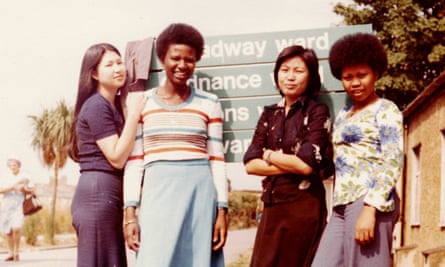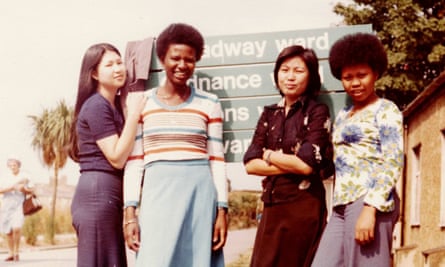The untold stories of Filipino nurses and other migrant workers in Britain is celebrated in a new roving exhibition to mark the 75th anniversary of the NHS.
The Migration Museum is launching its touring exhibition, Heart of the Nation: Migration and the Making of the NHS, at Leicester Museum and Art Gallery on 30 June until 29 October, the first leg of a national tour. The exhibition will go to Leeds in November and to London in 2024.
The immersive media exhibition highlights the “crucial” contributions of migrant workers to the NHS since its creation in 1948, which “have long been ignored”. It features dozens of personal stories contributed by people who have come from all over the world to work at all levels of the NHS from the 1940s to the present day, alongside photography, film, newly commissioned artwork, unique artefacts and historical ephemera.
At the centre of the exhibition is a newly commissioned interactive music and video installation, co-created and performed by seven people currently working in the NHS, exploring themes of care through singing and storytelling.
Healthcare workers from the Philippines and neighbouring countries in south-east Asia are among the many groups featured in the exhibition. More than 22,000 people from the Philippines were working for the NHS at the start of the Covid pandemic, according to a Commons library report, with the country being one of the world’s largest exporters of nurses.
“The story of south-east Asians and Filipinos in the health service hasn’t had the same acknowledgment, and hasn’t been highlighted as much as some of the other stories we’re more familiar with,” said Aditi Anand, the artistic director at the Migration Museum, who curated the exhibition.
“People from those countries have played a really important role, especially more recently, but also going all the way back to the 50s, 60s, and 70s.”
Filipino healthcare workers were particularly affected by the Covid-19 pandemic: the community faced the highest number of staff deaths in the NHS and social care, according to the Filipino Nurses Association, accounting for 22% of all staff deaths.
The stories highlighted in the exhibition, which were collated by Becky Hoh-Hale for the Ingat Ingat project, include those of Henedina Gadong, who came to the UK in 1976 and recalls how her supervisors underestimated her, despite her award-winning career performance; Mariacruz Appleton, who came in 1969 and says she felt like an “ambassador” for the Philippines as people in the UK were unfamiliar with the country; and Mirasol de Guzman, who came in 2000, leaving behind her family while she worked to build a better life for them in the UK.

Anand was particularly moved by Appleton’s story. “The reason the story has stuck with me is because of the incredible photographs and archives; she’s got this picture of her just getting off the plane at Heathrow dressed incredibly stylish, wearing a 1960s shift dress. There’s something about the imagery and being able to see people in all of their personalities, excitement, and the reasons that brought them here,” she said.
“Her story was really interesting because so many people came here to work without often knowing where they were going to be sent. She was a midwife back in the Philippines, but she and one of her midwife friends who came with her were sent to a psychiatric hospital. They went to do challenging mental health nursing, which they [had] never done before.”
Appleton’s experience was one shared by many migrant health workers. “There was such a shortage in nurses and doctors in particular specialities within the NHS that were considered less attractive to British-trained doctors and nurses. They were doing that essential job of filling the gap that existed,” Anand said.
Today, about one in six people working in the NHS has a non-British nationality, while many others are the children and grandchildren of migrant healthcare workers. “We have some idea of migration being an important part of the NHS, but not how central it is. Without migration the NHS really wouldn’t have survived in its early years,” Anand said.
“So much of the British healthcare system had relied on links of Britain’s former empire. We’ve got these amazing sets of photographs in the exhibition that show these medical colleges and institutes of hospitals that were set up by the British in their former colonies where you had training provided in the medical healthcare system of Britain. So it just created these longstanding links that go back hundreds of years.
“Even when these countries gained their independence, decolonised, those links always remained. You had the Nationality Act of 1948, that allowed people to then travel [as] subjects of the British empire and come to Britain. The NHS really can’t be understood without the context of an empire and how it enables the movement of people to come here and work.”
Join the exciting world of cryptocurrency trading with ByBit! As a new trader, you can benefit from a $10 bonus and up to $1,000 in rewards when you register using our referral link. With ByBit’s user-friendly platform and advanced trading tools, you can take advantage of cryptocurrency volatility and potentially make significant profits. Don’t miss this opportunity – sign up now and start trading!







Recent Comments